June 2024 is set to be an extraordinary month for stargazing and astronomy enthusiasts. Key events include the Lagoon Nebula reaching its highest point in the sky, oppositions of asteroids 43 Ariadne and 42 Isis, and the peaks of the Daytime Arietid and June Bootid meteor showers. Additionally, comets 154P/Brewington and 13P/Olbers will reach perihelion, offering prime viewing opportunities. This guide highlights these significant celestial occurrences, ensuring you won’t miss a moment of the night sky’s wonders.
Would you like to be notified of stargazing events?
List of Meteor Showers in June 2024
- Antihelion Source: Start on December 10; multiple peaks; end September 10.
- τ-Herculids: Start on May 25; peak on May 31; end on June 4.
- Daytime Arietids: Start on May 14; peak on June 7; end on June 24.
- June Bootids: Start on June 22; peak on June 27; end on July 2.
We also have a complete list of meteor showers for the entire year of 2024 here.
List of Planetary Conjunctions in June 2024
- Conjunction of the Moon and Mars in Pisces on June 2.
- Conjunction of Jupiter and Mercury in Taurus on June 4.
- Conjunction of the Moon and Jupiter in Taurus on June 5.
- Conjunction of the Moon and Saturn in Aquarius on June 27.
June 1: Close approach of the Moon and Neptune
The Moon and Neptune will make a close approach (appulse) passing within only 1.1 arcminutes of each other.
In some parts of the world this distance will be so close as to lead to a lunar occultation of Neptune, meaning the Moon will pass in front of Neptune thereby hiding it from view temporarily. If you’re in the southern tip of the African continent, you’re in luck! This includes the whole countries of South Africa, Namibia, Mozambique, Zambia, Madagascar, Botswana, Zimbabwe, Malawi, Swaziland, Lesotho, Comoros, Mayotte, Seychelles, as well as large parts of Angola and Tanzania.
Both objects will be in the constellation of Pisces with the Moon being at apparent magnitude -11.5; and Neptune at 7.9. The Moon will be a 24 days old waning crescent at 28%.


June 1: Messier 13 at its highest point in the sky
Messier 13 (also known as M13, NGC 6205, or the Great Globular Cluster in Hercules) is a globular star cluster located in the constellation of Hercules. It was discovered by English astronomer Edmond Halley in 1714 and later included in Charles Messier’s catalog.


At apparent magnitude 5.8, M13 can be seen with binoculars or a small telescope. The Moon will be a 24 days old waning crescent at 20%.
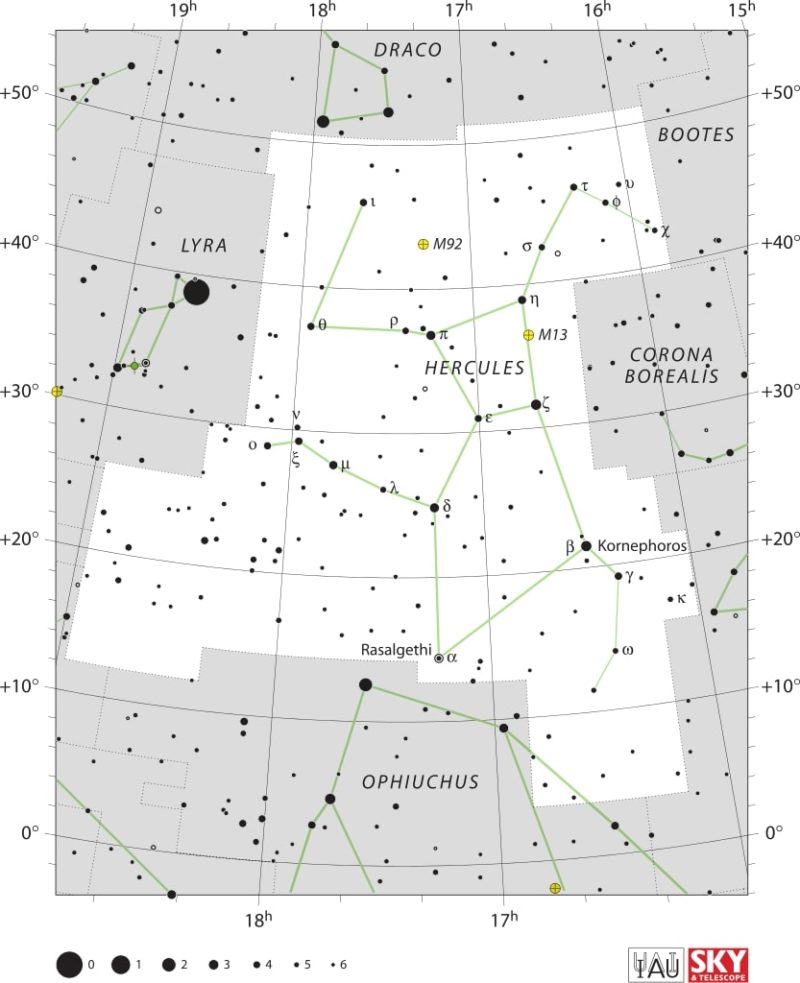

June 2: Conjunction of the Moon and Mars
The Moon and Mars will be at conjunction by sharing the same right ascension and passing within 2°24′ of each other.
Around the same time, the two bodies will also make a close approach (appulse) reaching 2°09′ from each other, but not sharing the same right ascension.
Look for the two bodies in the constellation of Pisces. (Constellation map already displayed above, when discussing the conjunction of the Moon and Neptune.) The Moon will be a very thin waning crescent (11%) at 26 days old, very close to new moon – and will not interfere much with stargazing this first half of June 2024. Despite this, the Moon will still be at apparent magnitude of -10.7, while Mars will be at magnitude 1.0.
June 3: Asteroid 43 Ariadne at opposition
Asteroid 43 Ariadne will reach opposition, when it lies opposite to the Sun in the sky. It will reach the highest point in the sky around midnight local time.
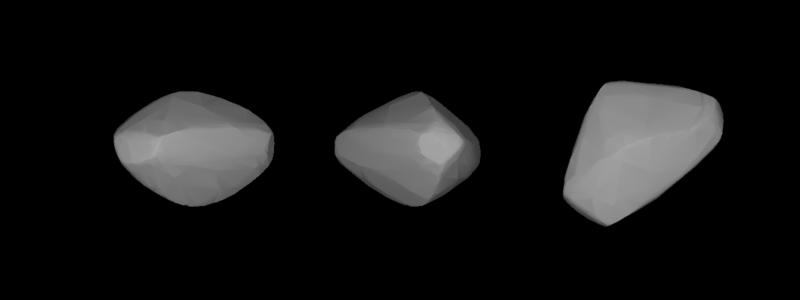

On this occasion, the asteroid Ariadne will pass within 0.85 AU of Earth and reach a peak brightness of apparent magnitude 9.1. Unfortunately even at the peak, this asteroid will be too faint to observe with the naked eye. You will need at least a 4 inch telescope, which you should point towards the constellation of Ophiuchus. The Moon will be a 26 days old waning crescent at 10%.


Ariadne is a large asteroid of the main belt at mean diameter of 71.34 km. It is a fairly large and bright main-belt asteroid. It orbits the Sun at a semi-major axis of 2.203 AU. (Source: NASA JPL Small-Body Database Lookup for 43 Ariadne.)
June 4: Conjunction of Jupiter and Mercury
Jupiter and Mercury will be at conjunction by sharing the same right ascension and passing within 7’04” of each other.
At around the same time the two planets will also make a close approach (appulse) reaching 6.8 arcminutes from each other, but not sharing the same right ascension.
The two planets will meet in the constellation of Taurus with an apparent magnitude of -2.0 for Jupiter and -1.1 for Mercury. The Moon will be a 27 days old waning crescent at 3%.
As Mercury is close to the Sun in the sky, be careful when observing this conjunction to never point binoculars or a telescope directly at the Sun. This can result in serious eye injuries or even permanent blindness.


June 5: Conjunction of the Moon and Jupiter
The Moon and Jupiter will reach conjunction passing within 4°40′ of each other while sharing the same right ascension.
The Moon will be at apparent magnitude -7.9 and Jupiter at magnitude -2.0 both in the constellation of Taurus. (Constellation map already displayed above, when discussing the Conjunction of Jupiter and Mercury.) The Moon will be a 28 days old waning crescent at less than 1%, only a day away from new moon.
Mercury will also be nearby, still lingering after its previous day’s conjunction with Jupiter.
June 7: Daytime Arietid meteor shower peak
The Daytime Arietids are a medium-sized meteor shower with an average of 50 meteors per hour (ZHR) during the peak if conditions are ideal.
Some meteors may also be spotted between May 14 and Jun 24, enriching your stargazing this late spring of 2024. They will radiate from the constellation of Aries at the speed of 38 km/s on average.


June 11: Comet 154P/Brewington at perihelion
The comet 154P/Brewington will reach perihelion, meaning it will reach the closest point in its orbit to the Sun at a distance of 1.55 AU. It will have an apparent magnitude of 11.3, so a large telescope would be required to observe this comet. Look in the constellation of Aries. (Constellation map already displayed above, when discussing the Daytime Arietid meteor shower peak.) The Moon will be 5 days old waxing crescent at 28%.
June 16: Butterfly cluster at its highest point in the sky
The Butterfly cluster (also known as Messier 6, M6, and NGC 6405) is an open star cluster located in the constellation of Scorpius. It was named this way because of a vague resemblance to a butterfly.
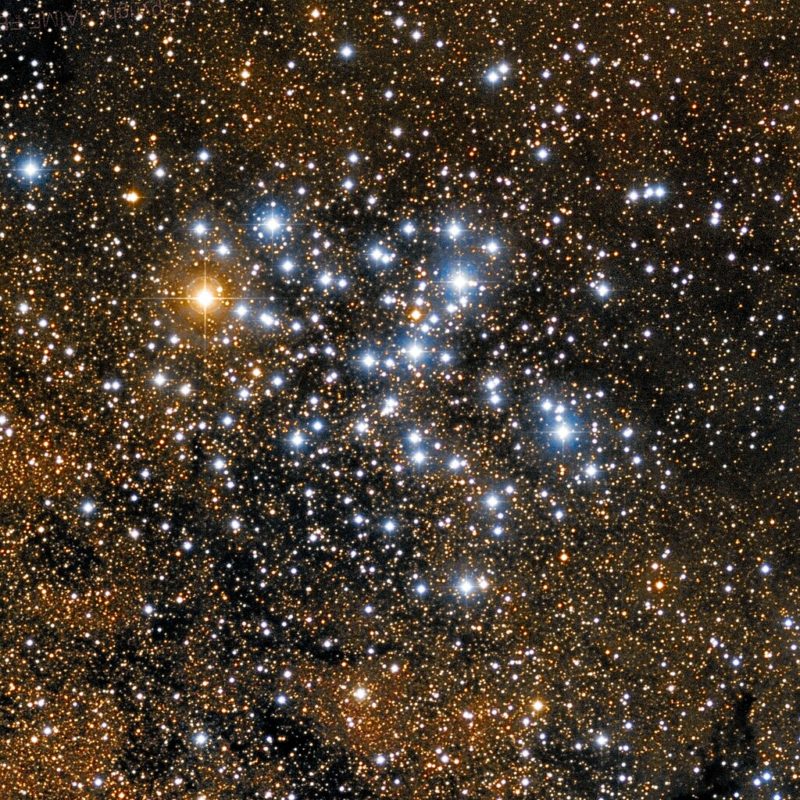

At apparent magnitude 4.2, M6 is very tricky to make out with the naked eye unless the conditions are near perfect. However it is easily visible with binoculars or a small telescope. The Moon will be 10 days old waxing gibbous at 78%.


June 20: June solstice
The June solstice will occur at 20:49 UTC. It will be the longest day and beginning of summer in the northern hemisphere and the shortest day and beginning of winter in the southern hemisphere.
June 20: Ptolemy cluster at its highest point in the sky
The Ptolemy cluster (also known as Messier 7, M7, or NGC 6475) is an open star cluster located in the constellation of Scorpius. (Constellation map already displayed above, when discussing the Butterfly cluster at its highest point in the sky.) As this cluster is visible to the naked eye, it was known since antiquity and was first recorded by Greek-Roman astronomer Ptolemy in 130 AD.
At apparent magnitude 3.3, M7 is visible to the naked eye, but with ideal conditions. Use binoculars or a small telescope for better viewing. The Moon will be a 14 days old waxing gibbous at 99%, only 2 days away from a full moon.


June 22: Lagoon Nebula at its highest point in the sky
The Lagoon Nebula (also known as Messier 8, M8, or NGC 6523) in the constellation of Sagittarius is a giant interstellar cloud classified as an emission nebula and includes an H II region. (See featured image at the top of the article.)
At apparent magnitude 5.8, the Lagoon Nebula is easily visible with binoculars or a small telescope. The Moon will be 16 days old at full moon.


June 27: June Bootid meteor shower peak
The June Bootids will peak this June 2024 with a variable zenithal hourly rate if stargazing conditions are optimal.
Some meteors may also be spotted between June 22 and July 2. They will radiate from the constellation of Boötes at the low speed of 18 km/s on average. The meteors from this shower originate from comet 7P/Pons-Winnecke.


June 27: Conjunction of the Moon and Saturn
The Moon and Saturn will reach conjunction passing within 4’38” of each other while sharing the same right ascension.
At around the same time the two bodies will also make a close approach (appulse) reaching 4’38” arcminutes from each other, but not sharing the same right ascension. In some parts of the world this distance will be so close as to lead to a lunar occultation of Saturn, meaning the Moon will pass in front of Saturn thereby hiding it from view temporarily. If you’re in eastern Australia, north-eastern New Zealand, Fiji and New Caledonia among others, you’re in luck!
The Moon will be at apparent magnitude -12.2 and Saturn at magnitude 0.8 both in the constellation of Aquarius. The Moon will be 21 days old waning gibbous at 59%.
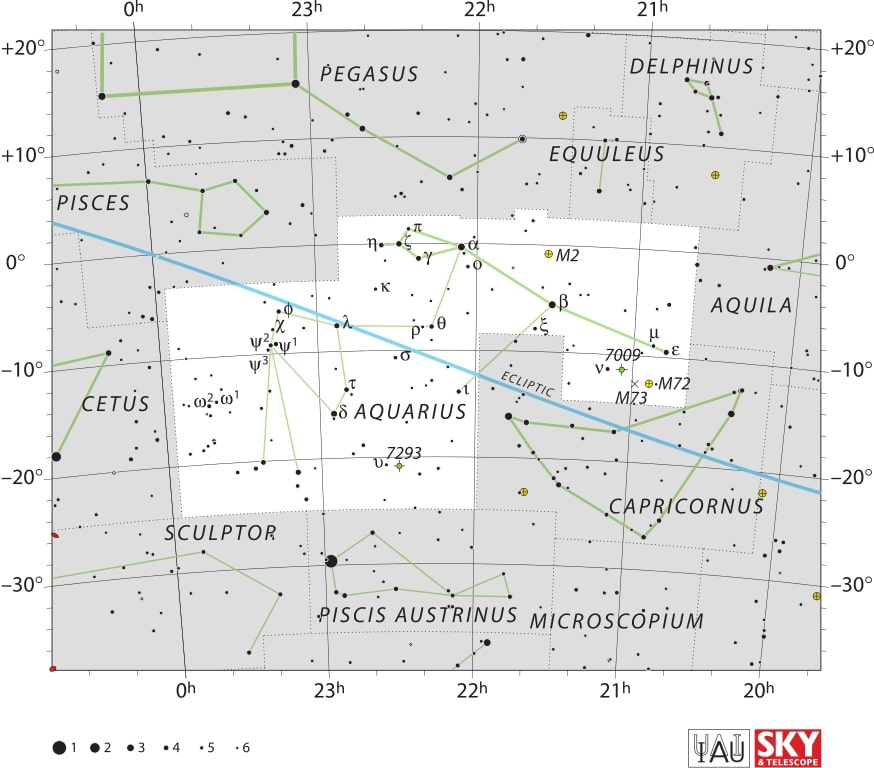

June 28: Asteroid 42 Isis at opposition
Asteroid 42 Isis will reach opposition, when it lies opposite to the Sun in the sky. It will reach the highest point in the sky around midnight local time.


On this occasion, the asteroid 42 Isis will pass within 0.99 AU of Earth and reach a peak brightness of apparent magnitude 9.4. Unfortunately even at the peak, this asteroid will be too faint to observe with the naked eye. You will need at least a 4 inch telescope, which you should point towards the constellation of Sagittarius. (Constellation map already displayed above, when discussing the Lagoon Nebula at its highest point in the sky.) The Moon will be 21 days old waning gibbous at 53% so may interfere with observations somewhat.
42 Isis is a large asteroid of the main belt at mean diameter of 110.997 km. It orbits the Sun at a semi-major axis of 2.443 AU. (Source: NASA JPL Small-Body Database Lookup for 42 Isis.)
June 28: Close approach of the Moon and Neptune
The Moon and Neptune will make a close approach (appulse) passing within only 15.6 arcminutes of each other.
In some parts of the world this distance will be so close as to lead to a lunar occultation of Neptune, meaning the Moon will pass in front of Neptune thereby hiding it from view temporarily. If you’re in Brazil, Peru, Colombia and Venezuela among others, you’re in luck!
Both objects will be in the constellation of Pisces with the Moon being at apparent magnitude -12.1; and Neptune at 7.9. (Constellation map already displayed above, when discussing the conjunction of the Moon and Neptune.) The Moon will be a 22 days old waning gibbous at 50%.
June 30: Comet 13P/Olbers at perihelion
The comet 13P/Olbers will reach perihelion, meaning it will reach the closest point in its orbit to the Sun at a distance of 1.18 AU. It will have an apparent magnitude of 5.0 according to the BAA Comet Section, so binoculars or a small telescope would be required to observe this periodic comet with an orbital period of 69 years. Look in the constellation of Lynx. The Moon will be 24 days old waning crescent at 27%.
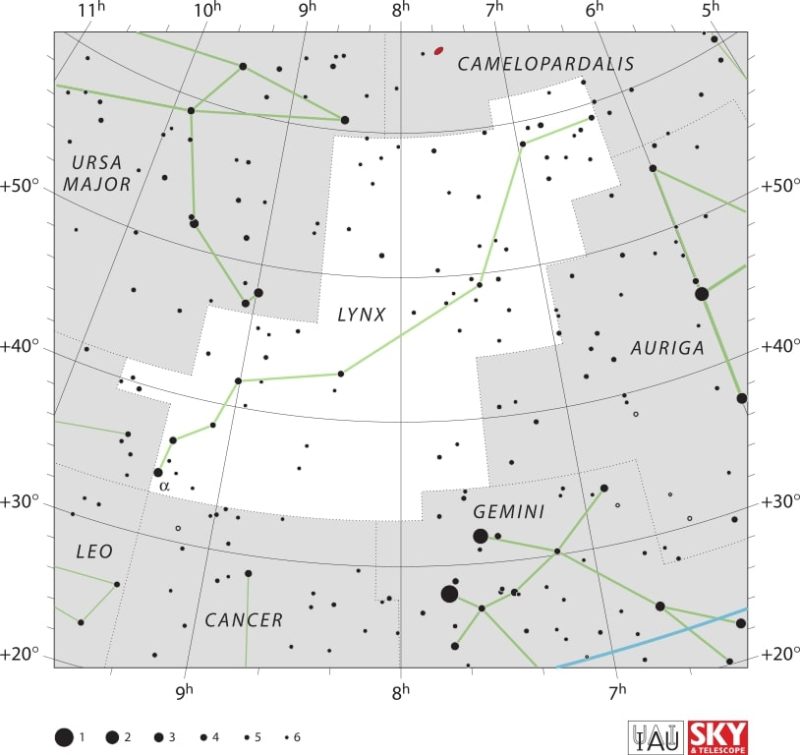

Moon Phases in June 2024
As you know, the Moon has a big impact on the visibility of celestial bodies and astronomical events in the night sky. So to help you with stargazing, here’s a calendar of the phases of Moon for this month of June 2024:
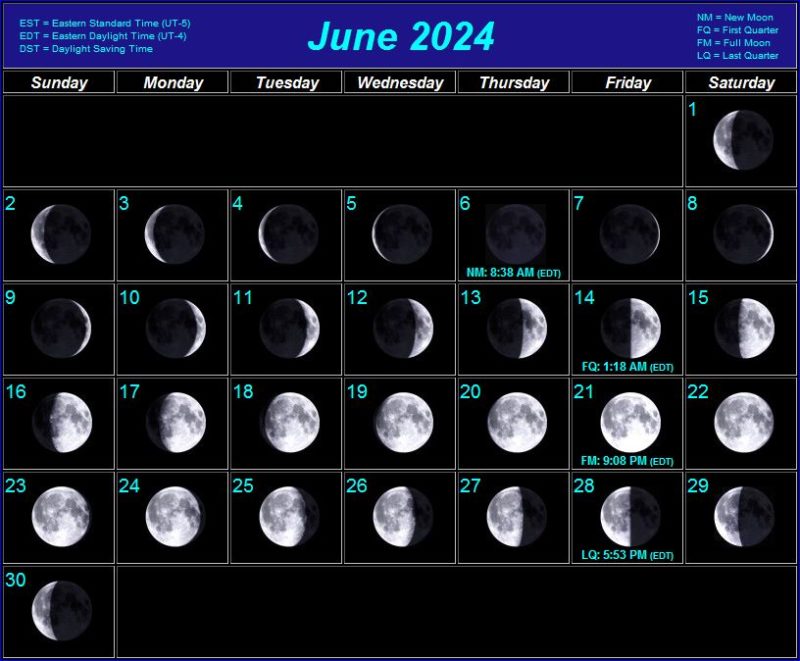

Positions of the Planets in June 2024
Mercury: The closest planet to the Sun can be seen at dawn and dusk travelling across the constellation of Taurus. This planet, being the closest to the Sun, will appear to move quickly in the night sky and its position will change in the following weeks.
Venus: The sister planet can be seen travelling across the constellation of Taurus. Just like Mercury, Venus can only be seen at dawn and dusk.
Mars: The red planet can be seen in the constellation of Pisces.
Jupiter: The gas giant is visible in the constellation of Taurus. Jupiter can easily be spotted with the naked eye, even in highly illuminated cities.
Saturn: The ringed giant can be seen with the naked eye in the constellation of Aquarius.
Uranus: The ice giant can be seen in the constellation of Taurus with the use of a telescope.
Neptune: The blue giant requires a telescope pointed in the constellation of Pisces in order to be seen.
Positions of Dwarf Planets and Large Asteroids in June 2024
Ceres: The asteroid belt’s lone dwarf planet can be seen in the constellation of Sagittarius with the help of a telescope.
Vesta: This large asteroid can be seen in the constellation of Gemini with a telescope.
Pallas: The asteroid can be observed with a telescope in the constellation of Corona Borealis.
Pluto: This distant dwarf planet can be found in the constellation of Capricornus with the help of a large telescope.
Major astronomical events next month – July 2024
- July 6: Ceres at opposition.
- July 10: July Pegasid meteor shower peak.
- July 23: Pluto at opposition.
- July 28: Piscis Austrinid meteor shower peak.
- July 30: Southern δ-Aquariid meteor shower peak.
- July 30: α-Capricornid meteor shower peak.
Conclusion
Stargazing in June 2024 offers a remarkable array of astronomical events. From nebulae and asteroids to meteor showers and comets, this month is filled with opportunities for enthusiasts to observe the night sky’s wonders. Make the most of these events to deepen your appreciation of astronomy and enjoy the celestial show.
So, mark your calendars and don’t forget to subscribe to our newsletter below to receive our stargazing calendar in your mailbox. Happy stargazing!
Sources:
See also: